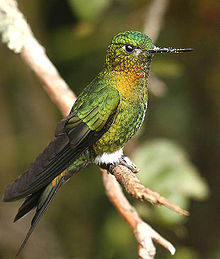| Golden-breasted puffleg | |
|---|---|

| |
| Yanacocha, Ecuador | |
| Conservation status | |
 Least Concern (IUCN 3.1) | |
| CITES Appendix II (CITES) | |
| Scientific classification | |
| Domain: | Eukaryota |
| Kingdom: | Animalia |
| Phylum: | Chordata |
| Class: | Aves |
| Clade: | Strisores |
| Order: | Apodiformes |
| Family: | Trochilidae |
| Genus: | Eriocnemis |
| Species: | E. mosquera |
| Binomial name | |
| Eriocnemis mosquera (Delattre & Bourcier, 1846) | |

| |
The golden-breasted puffleg (Eriocnemis mosquera) is a species of hummingbird in the "brilliants", tribe Heliantheini in subfamily Lesbiinae. It is found in Colombia and Ecuador.
Taxonomy and systematics
The golden-breasted puffleg is monotypic. However, at one time it was suggested that the northern and southern populations formed subspecies.
Description
The golden-breasted puffleg is about 11 to 13 cm (4.3 to 5.1 in) long and weighs about 5.3 g (0.19 oz). It has a straight black bill. The male has shining green upperparts with a bronzier green nape and rump. Its underparts are mostly glittering golden green. Its lower throat and upper breast are coppery bronze and the undertail coverts brownish. Its leg puffs are white. The tail is forked; its central feathers are blue-green and the outer two pairs dark green to blue-black. The female is slightly smaller and has somewhat greener undertail coverts but is otherwise similar to the male.
Distribution and habitat
The golden-breasted puffleg is found in the Central and Western Andes of Colombia with a few records in the Eastern Andes. It also occurs in much of the length of the Andes in Ecuador. The species inhabits the edges and clearings of stunted montane forest, elfin forest, and shrubby zones near treeline. In elevation in Colombia it ranges between 1,200 and 3,600 m (3,900 and 11,800 ft) but is usually found above 2,600 m (8,500 ft). In Ecuador it mostly occurs between 3,000 and 3,600 m (9,800 and 11,800 ft).
Behavior
Movement
The golden-breasted puffleg is suspected to make seasonal elevational movements but has not been documented doing so.
Feeding
The golden-breasted puffleg forages for nectar at low flowers, both while hovering and by clinging to the flower. It is "active and aggressive" defending feeding territories. No details of its preferred plants are known. It also feeds on small insects like other hummingbirds.
Breeding
Little is known about the golden-breasted puffleg's breeding phenology. A nest discovered in November in Colombia was a cup made of moss and sticks lined with plant down, placed on the end of a slender branch under a rock overhang. An adult was on the nest so the observer assumed that it was incubating eggs.
|
Songs and calls Listen to golden-breasted puffleg on xeno-canto |
Vocalization
The golden-breasted puffleg's calls are "trit notes".
Status
The IUCN has assessed the golden-breasted puffleg as being of Least Concern. Though it has a fairly small range and its population size is not known, the population is believed to be stable. No immediate threats have been identified. It is deemed common in Colombia and uncommon to fairly common in Ecuador. "Human activity has little short-term direct effect on Golden-breasted Puffleg, other than the local effects of habitat destruction".
References
- ^ BirdLife International (2017). "Golden-breasted Puffleg Eriocnemis mosquera". IUCN Red List of Threatened Species. 2017: e.T22687933A112392274. doi:10.2305/IUCN.UK.2017-1.RLTS.T22687933A112392274.en. Retrieved 15 March 2022.
- "Appendices | CITES". cites.org. Retrieved 2022-01-14.
- ^ Gill, F.; Donsker, D.; Rasmussen, P., eds. (January 2022). "Hummingbirds". IOC World Bird List. v 12.1. Retrieved January 15, 2022.
- HBW and BirdLife International (2020) Handbook of the Birds of the World and BirdLife International digital checklist of the birds of the world Version 5. Available at: http://datazone.birdlife.org/userfiles/file/Species/Taxonomy/HBW-BirdLife_Checklist_v5_Dec20.zip retrieved 27 May 2021
- ^ Schulenberg, T. S. (2020). Golden-breasted Puffleg (Eriocnemis mosquera), version 1.0. In Birds of the World (T. S. Schulenberg, Editor). Cornell Lab of Ornithology, Ithaca, NY, USA. https://doi.org/10.2173/bow.gobpuf1.01 retrieved March 15, 2022
| Taxon identifiers | |
|---|---|
| Eriocnemis mosquera |
|
| Trochilus mosquera | |
